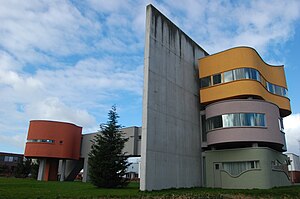17:
84:“Life has to do with walls; we're continuously going in and out, back and forth, and through them. A wall is the quickest, the thinnest, the element we're always transgressing… The wall heightens the sense of passage, and by the same token, its thinness heightens the sense of being just a momentary condition…what I call the moment of the “present.”
96:“After that experience,” he says, “I could never do another white or primary-colored house.” In the La Roche house, the colors “were hardly apparent at first, but after you were there awhile you saw not only that they changed constantly, but that they were delicate and muted, and also saturated at the same time.”
138:
and construction techniques-which required, for example, leaving space between the wall and rooms for hand plastering-the house was enlarged from its original size, to 2500 square feet. Muller redrew the plans with Derk
Flikkema of Otonomo Architects in Groningen, with Hejduk reviewing the drawings
131:, and Olof van de Wal, the head of Platform Gras, a city-sponsored architectural group. For 11 years, Verdonk and Van de Wal worked to develop Wall House II. Eventually, the Wilma BV Developers and Kamminga estate agents agreed to build the house and sell it.
50:. However, due to cost constraints, the project was abandoned. In 2000, a Dutch development company, Wilma, started building the house in Groningen, based on Hejduk's original design and later revisions.
124:
masterplan, people from various disciplines were asked to design signposts along the city’s most important arterial roads, telling the story of
Groningen. Libeskind was a former student of Heiduk.
134:
The Berlin architect Thomas Muller, a former student at Cooper Union, was appointed project architect. He was then working in
Groningen under supervision of Kleihues. Due to
117:. Due to the high estimated costs of construction in the wooded area, Wall House II was put on hold. it was proposed to other clients, but was never started.
211:
69:
Wall House II was constructed in the
Hoornse Meer neighborhood with a view across the Paterwoldse Meer. The wall and column are constructed of reinforced
53:
Wall House II has a very large wall as its central feature, composed of four organic-formed rooms and a long, narrow corridor. It is considered a mix of
120:
In 1990 the Wall house II project was introduced in
Groningen on behalf of the experiment “Making the City Boundaries”. On the basis of
172:
110:
142:
The construction cost was $ 600,000 in total, and it was sold with a proviso that the public can visit it one month a year.
216:
154:
Hejduk, John. Mask of medusa: works 1947-1983; ed. by Kim
Shkapich. New York: Rizzoli International Publications, 1985.
157:
Martin, Marijke. “Hejduk's Wall House #2 realized in
Groningen.” Architecture and Urbanism 375 (2001): 102-09
160:
Sveiven, Megan. "AD Classics: Wall House 2 / John Hejduk" 06 Feb 2012. ArchDaily. Accessed 07 Oct 2012.
105:
Hejduk originally designed Wall house II in 1973 (the first was done in 1968) for landscape architect
166:
Gorlin, Alexander. “Wall House, Groningen, the
Netherlands.” Architectural Record 189 (2001): 150-53
47:
151:
Wal, O. and Wolff, A., Wall House #2: John Hejduk in
Groningen. Groningen: Platform GRAS, 2001.
36:
8:
127:
Wall House II was realized through the efforts of Niek
Verdonk, Groningen’s director of
32:
121:
106:
205:
187:
174:
135:
128:
109:. Hejduk was an architect, artist and educator who later became Dean of the
114:
89:
40:
58:
46:
Hejduk originally designed Wall House II as a residence to be built in
70:
161:
74:
54:
80:
In discussing the wall section of Wall House II Hejduk stated:
16:
73:. The corridor is steel-framed with wooden stud walls and a
113:
at Cooper Union. Bye was a fellow faculty member at
203:
88:Discussing the house colors, Hejduk referred to
212:Buildings and structures in Groningen (city)
43:. It is one of his few realized designs.
15:
204:
111:Irwin S. Chanin School of Architecture
92:’s La Roche House in Paris, stating:
139:in each phase up until his death.
13:
14:
228:
64:
1:
145:
61:sculpture and architecture.
7:
10:
233:
100:
217:Houses in the Netherlands
48:Ridgefield, Connecticut
39:, that was designed by
98:
86:
37:Groningen, Netherlands
21:
94:
82:
19:
184: /
188:53.1831°N 6.5530°E
122:Daniel Libeskind’s
22:
33:historic building
20:The Wall House II
224:
199:
198:
196:
195:
194:
189:
185:
182:
181:
180:
177:
232:
231:
227:
226:
225:
223:
222:
221:
202:
201:
193:53.1831; 6.5530
192:
190:
186:
183:
178:
175:
173:
171:
170:
148:
103:
67:
27:(also known as
12:
11:
5:
230:
220:
219:
214:
168:
167:
164:
158:
155:
152:
147:
144:
136:building codes
102:
99:
66:
63:
29:Wall House II)
9:
6:
4:
3:
2:
229:
218:
215:
213:
210:
209:
207:
200:
197:
165:
163:
159:
156:
153:
150:
149:
143:
140:
137:
132:
130:
129:city planning
125:
123:
118:
116:
112:
108:
97:
93:
91:
85:
81:
78:
76:
72:
62:
60:
56:
51:
49:
44:
42:
38:
34:
30:
26:
18:
169:
141:
133:
126:
119:
115:Cooper Union
104:
95:
90:Le Corbusier
87:
83:
79:
68:
65:The building
52:
45:
28:
24:
23:
191: /
77:exterior.
41:John Hejduk
206:Categories
176:53°10′59″N
146:References
59:Surrealist
57:painting,
179:6°33′11″E
25:Bye House
107:A.E. Bye
71:concrete
101:History
162:Online
75:stucco
55:Cubist
31:is a
35:in
208::
Text is available under the Creative Commons Attribution-ShareAlike License. Additional terms may apply.
